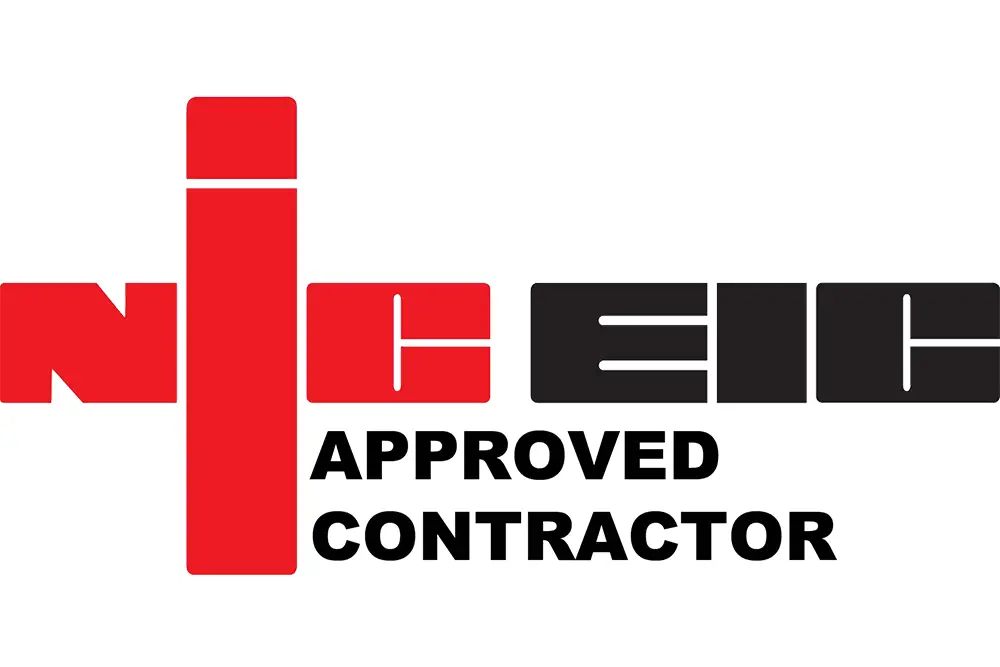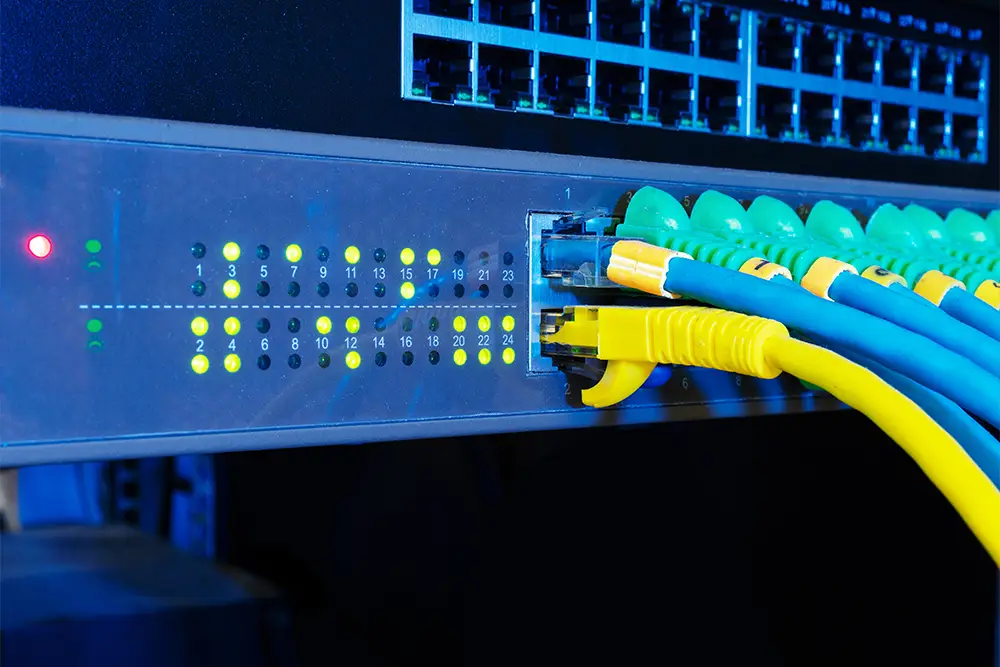Why Good Cabling Matters
In today’s connected world data centres are the backbone of everything from business to schools and shops. Key components such as the cabling system are crucial for seamless connectivity and operational efficiency in data flow management.
At the heart of these complex systems is something often overlooked: the cabling. Good cabling isn’t just about connecting devices. It’s the nervous system of your entire network, that affects how well it performs, how reliable it is and how easily it can grow. And accounting for future requirements in the design of data centre cabling infrastructure is essential for scalability and future upgrades and expansions.
As an NICEIC approved electrical contractor with years of experience in installing data cables across Birmingham and the UK, RJ Electrical Contractors knows how important good cabling solutions are. Our team provides high quality installations that meet all standards and deliver the reliability modern businesses need. Our cabling systems support networking equipment, to ensure optimal performance and productivity in modern businesses.
What is a Data Centre?
Data centres are the heart of modern businesses, housing and managing the critical infrastructure for data storage, processing and transmission. These facilities are critical for network availability, reliability and performance, to provide a service to users across all sectors.
A well designed data centre infrastructure is critical for data transmission and minimising downtime. This means careful planning and design of the data centre facility itself, for optimal energy efficiency, sustainability and scalability. Data centre management is key to business continuity, minimising losses and overall service quality.
Data centre management is about optimising resources, including computing resources, storage systems and cabling infrastructure to deliver services reliably. A data centre strategy must consider multiple sites, multiple paths and future expansion requirements to provide reliability and avoid costly downtime.
The installation of data centre infrastructure must be meticulously planned and executed to minimise disruption to services and optimal energy efficiency. Data centre infrastructure must be designed with future expansion in mind, considering issues such as cooling systems, power consumption and connectivity.
By investing in a well designed data centre infrastructure businesses can ensure reliable and efficient data transmission, minimise downtime and provide a high quality service to users. This investment supports current operations and prepares the business for future technological advancements and growth.
Understanding Structured Cabling
Structured cabling (aka structured data cabling) is an organised approach to designing and installing network cabling systems. Unlike messy “spaghetti cabling” that connects points directly, structured cabling follows organised methods and industry standards to create a system that’s cohesive, scalable, and easy to manage.
The main difference between structured and unstructured cabling is organisation and future-proofing. While unstructured cabling might seem cheaper at first, the long-term costs of maintenance, troubleshooting, and replacement make structured cabling the better investment for any serious organisation.
Key Parts of a Structured Cabling System
A good structured cabling system has several important subsystems working together:
- Entrance Facilities – Where external service provider networks connect to your internal network
- Equipment Rooms – Dedicated spaces for core network equipment like servers and switches
- Backbone Cabling – High-capacity connections between equipment rooms, typically using fibre optic cables
- Horizontal Cabling – Runs from telecommunications rooms to individual workstations, usually through ceilings or under floors
- Telecommunications Rooms – Distribution points for horizontal cabling
- Work Area Components – End-user connection points including wall plates and patch cables
Cabling Solutions
Different environments require different cabling solutions based on performance needs, distance limits and environmental factors.

Copper Cabling:
Cat5e: Up to 1 Gbps, common in existing installs
Cat6: 10 Gbps short distance, good for most businesses
Cat6a: 10 Gbps with better noise resistance, modern offices
Cat7: Higher frequencies with fully shielded construction for special needs

Fibre Optic Cabling:
Fibre optic cabling has better bandwidth and distance capabilities, single-mode fibre for long distances and multimode (OM3, OM4, OM5) for shorter distances.
For data centres, MTP/MPO systems offer high density fibre solutions, multiple fibre connections in one connector and easy upgrades as needs grow.
Choosing the right cabling depends on many factors, your needs, environmental conditions, distance limits and budget. At RJ Electrical Contractors we help clients find the right solution for their situation
Best Practices
Planning and Documentation
Good cabling starts with planning. Before you even start installation, site surveys are done to assess the existing infrastructure, physical space and requirements. This information is used to create detailed documentation of the entire cabling system.
Key Planning Points:
Site surveys and infrastructure assessment
Cable types, pathways and termination points
Consistent and consistent labelling
Forward-thinking
Following industry standards and regulations
This is the most important but often overlooked part of a successful implementation. The time spent on planning pays off during the installation and the life of the infrastructure.
Physical Layouts and Cabling
Physical organisation is key to performance and maintenance. Racks and cabinets are strategically placed to reduce cable lengths and airflow to cool the equipment which is important for equipment life and energy efficiency.
Power cables and data cables are kept separate to prevent interference that can degrade network performance. Cable support systems including cable trays, ladders and support mechanisms prevent cable stress and maintain bend radius to ensure signal integrity long term.
The physical layout also considers environmental factors such as temperature control, humidity management and access security all important parts of a robust data centre.
Performance Optimisation Tips
Maximum network performance requires more than just choosing the right cables:
- Cable Selection – Based on application, environment and distance
- Termination Techniques – All connections must meet industry standards for signal integrity
- Testing and Certification – All installed cables must meet or exceed spec
- Environmental Considerations – Temperature, humidity and EMI
- Future Proofing – Choose cabling that exceeds current bandwidth
Using metrics to measure performance is key. MTBF, signal quality and packet loss help you gauge the overall performance of your network.
With attention to these performance factors you can build a network infrastructure that delivers today and has room to grow and adapt to future technologies.
Structured Cabling in Different Environments
Corporate Data Centres and Office Spaces
Corporate environments require the highest performance and reliability. Business operations depend on uninterrupted data access so critical connections need redundant pathways to prevent single points of failure.
Corporate Requirements:
Redundant pathways for critical connections
High speed fibre optic backbone connections
Support for modern office technologies
Physical security considerations
Professional cable management for workspace appearance
RJ Electrical Contractors has many years of experience in installing structured cabling solutions in corporate environments across Birmingham and the UK, providing reliable high performance infrastructure to support business growth and technology advancements.
Educational Facilities and Colleges
Educational environments present unique cabling challenges. Modern educational facilities need robust cabling systems to support dense wireless deployments across lecture theatres, libraries, classrooms and common areas – all critical to today’s digital learning environments.
The infrastructure must support digital learning tools, smart classrooms and multimedia applications that enhance the learning experience. Unlike corporate environments, educational facilities have seasonal usage patterns with dramatic changes in network demand between term time and holidays.
Educational Considerations:
Support for high density wireless deployments
Integration with digital learning technologies
Accommodation for seasonal usage patterns
Compliance with British educational facility standards
Cost effectiveness with future scalability
RJ Electrical Contractors understands these challenges, delivering solutions that support interactive displays, distance learning systems and student response systems within educational budgets.
Commercial and Retail Environments
Retail and commercial spaces need special cabling solutions that cater for their unique operational requirements. Reliable connectivity for point of sale systems, inventory management and payment processing is the backbone of modern retail, with network downtime impacting revenue.
Integrated security systems, including CCTV, access control and alarm systems require cabling infrastructure that works seamlessly with these business critical systems. Unlike other environments, retail spaces are frequently reconfigured and seasonal so need flexible infrastructure.
Retail Priorities:
Support for point of sale and inventory systems
Integration with security and surveillance systems
Flexibility for store reconfigurations
Minimal disruption during installation and maintenance
Aesthetic considerations that match store design
Reliability and Performance

Standards
As a NICEIC approved contractor RJ Electrical Contractors comply with all relevant industry standards:
- BS7671: IET Wiring Regulations
- TIA/EIA-568: Commercial Building Telecommunications Cabling Standard
- ISO/IEC 11801: Information Technology – Generic Cabling for Customer Premises
- ANSI/BICSI-002: Data Centre Design and Implementation Best Practices
- EN 50173: Information Technology – Generic Cabling Systems
- British Standards 6701, 50173 and 50174 for UK implementations
These standards provide the framework for designing, installing and maintaining cabling systems that deliver performance and compatibility across vendors and applications. Our commitment to standards means our clients get infrastructure that meets or exceeds industry requirements for performance, reliability and safety.

Testing and Certification
Testing validates system integrity and performance with documented evidence of compliance to specifications. Our testing process includes:
- Cable Certification – Testing each installed cable to specified performance parameters
- End-to-End Verification – Verifying connectivity and performance from source to destination
- Performance Validation – Ensuring compliance to bandwidth, attenuation and crosstalk requirements
- Documentation – Providing test results and certification for all components
- Compliance Verification – Verifying to relevant standards and specifications
Network failures can have a big impact on service availability and reliability. High demand exceeding capacity can cause service unavailability so it’s essential to measure outage frequency and how well the network design mitigates failures.

Maintenance Best Practices
The life and performance of structured cabling systems depends on good maintenance practices:
- Regular visual inspections to identify potential issues
- Consistent documentation updates to reflect system changes
- Keeping cable pathways and equipment spaces clean
- Clear procedures for adds, moves and changes
- Performance monitoring systems for visibility
Lost packets can impact network reliability and performance as they often require retransmission, increasing energy consumption and latency. Monitoring and managing lost packets is key to optimal network performance.
Future-Proofing Your Cabling Infrastructure
Scalability
Planning for growth is key to cabling infrastructure design. Forward thinking implementations include extra capacity in pathways, spaces and connection points so you can expand without major reconstruction.
Modular design allows for incremental growth without disrupting business as usual, for growing businesses. Choosing higher grade cabling than you need today gives you headroom for increasing bandwidth demands and extends the life of the infrastructure.
Emerging Technologies and Trends
Staying ahead of technology demands means being aware of emerging trends and what they mean for your cabling infrastructure:
Key Trends:
- IoT device growth
- PoE for cameras, access points and sensors
- Next gen fibre for higher bandwidth
- AI and data analytics applications
- 5G wireless integration
Cost and ROI
Understanding the total cost of cabling infrastructure means looking beyond initial install costs to total lifecycle value. A full lifecycle analysis looks at ownership costs over the life of the cabling system including install, maintenance, upgrades and replacement.
Key ROI’s:
- Preventing network downtime
- Reduced maintenance and troubleshooting
- Avoiding early system upgrades
- Productivity from a reliable infrastructure
- Extending the life of the cabling system
The Basis of Network Excellence
Properly installed structured cabling solutions are the foundation of all other network technologies. By following best practice and designing cabling infrastructure thoughtfully, organisations can ensure reliability, simplify maintenance and have the flexibility to adapt to changing technology requirements.
Whether in corporate data centres, educational facilities or retail environments the principles of proper cable management, standards compliance and forward thinking design are the same. Investing in quality structured cabling solutions is not just an infrastructure cost but a strategic investment in operational reliability and future technology capabilities.
Get in touch with RJ Electrical Contractors today to talk to our team about designing and installing the structured cabling solution your organisation needs.
Network Reliability and Uptime
Network reliability is key to data centre uptime and availability. Even short periods of downtime can be costly, so network reliability is paramount. Network availability is measured as a percentage of time the infrastructure is operational over a given period, high availability is business critical.
Network reliability is measured by MTBF and failure rate, a lower failure rate means higher reliability. Data centre managers must prioritise network reliability and uptime, implement redundant systems, regular maintenance and proactive monitoring to minimise downtime.
Network performance is also critical, latency, bandwidth and packet loss all impact the service. Reliable network performance is essential for business critical applications and services, downtime or poor performance can mean lost productivity and revenue. Data centre managers have to balance high network reliability and uptime with resource efficiency, energy consumption and equipment usage. By investing in reliable network infrastructure and good management practices businesses can have high network reliability and uptime, minimal downtime and business continuity.
Network reliability and uptime are key to overall service quality. High reliability and uptime is critical for business critical applications and services, for business success and competitiveness. By prioritising network reliability and uptime data centre managers can support growth, innovation and customer satisfaction and ultimately the long term success of the business.
The RJ Electrical Contractors Advantage
At RJ Electrical Contractors we combine electrical services and data cabling to provide a complete solution for our clients. Our NICEIC accreditation means all work is to the highest standards in accordance with industry regulations and best practice, so you can have confidence in safety and performance.
What We Offer:
- NICEIC accreditation for work to the highest standards
- Experienced project management from consultation to completion
- Nationwide service from our Birmingham office
- Full compliance with BS7671 and all relevant cabling standards
- Testing and certification documentation
- Long term support and maintenance services
Our relationship with you doesn’t end after installation, we offer maintenance, support and upgrade services to get the most out of the installed infrastructure.











